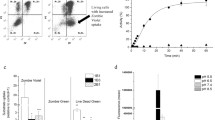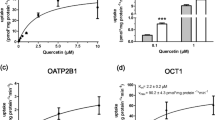Abstract
Purpose
In this study, we investigated organic anion transporting polypeptide 2B1 (OATP2B1)-mediated uptake of fluorescent anions to better identify fluorescent substrates for in vitro OATP2B1 assays. The OATP2B1 is involved in the intestinal absorption and one of the pharmacokinetic determinants of orally administered drugs.
Methods
A microplate reader was used to determine the cellular accumulation of the fluorescent compounds into the OATP2B1 or the empty vector-transfected HEK293 cells.
Results
Two types of derivatives were found to be OATP2B1 substrates: heavy halogenated derivatives, such as 4′,5′-dibromofluorescein (DBF), and carboxylated derivatives, such as 5-carboxyfluorescein (5-CF). The DBF and 5-CF were transported in a time and concentration-dependent manner. The DBF was transported at a broad pH (pH 6.5–8.0) while 5-CF was transported at an acidic pH (pH 5.5–6.5). The Km values were 0.818 ± 0.067 μM at pH 7.4 for DBF and 8.56 ± 0.41 μM at pH 5.5 for 5-CF. The OATP2B1 inhibitors, including atorvastatin, bromosulfophthalein, glibenclamide, sulfasalazine, talinolol, and estrone 3-sulfate, inhibited the DBF and the 5-CF transport. Contrastively, testosterone, dehydroepiandrosterone sulfate, and progesterone inhibited the DBF transport but stimulated the 5-CF transport. Natural flavonoid aglycones, such as naringenin and baicalein, also exhibited substrate-dependent effects in this manner.
Conclusion
We found two fluorescein analogs, DBF and 5-CF as the OATP2B1 substrates that exhibited substrate-dependent interactions.








Similar content being viewed by others
Abbreviations
- 5-AF:
-
5-aminofluorescein
- 5-CF:
-
5-carboxyfluorescein
- 6-CF:
-
6-carboxyfluorescein
- AUC:
-
Area under the curve
- BSP:
-
bromosulfophthalein
- CDCF:
-
5-carboxy-2′,7′-dichlorofluorescein
- CDCSF:
-
5-carboxy-2′,7′-dichlorosulfonfluorescein
- COR:
-
Corticosterone
- E1S:
-
Estrone 3-sulfate
- E2G:
-
Estradiol-17β-glucuronide
- DBF:
-
2′,7′-dibromofluorescein
- DCF:
-
2′,7′-dichlorofluorescein
- DDI:
-
Drug-drug interaction
- DEX:
-
Dexamethasone
- DHEAS:
-
Dehydroepiandrosterone sulfate
- EY:
-
Eosin Y
- FDI:
-
Food-drug interaction
- FL:
-
Fluorescein
- OG:
-
Oregon Green
- OATP:
-
Organic anion transporting polypeptide
- PRO:
-
Progesterone
- RB:
-
Rose bengal
- Rho123:
-
Rhodamine123
- SF:
-
sulfonfluorescein
- TET:
-
Testosterone
References
Hagenbuch B, Meier PJ. Organic anion transporting polypeptides of the OATP/SLC21 family: phylogenetic classification as OATP/SLCO super-family, new nomenclature and molecular/functional properties. Pflugers Arch Eur J Physiol. 2004;447:653–65.
Obaidat A, Roth M, Hagenbuch B. The expression and function of organic anion transporting polypeptides in normal tissues and in cancer. Annu Rev Pharmacol Toxicol. 2012;52:135–51.
Tamai I. Oral drug delivery utilizing intestinal OATP transporters. Adv Drug Deliv Rev. 2012;64:508–14.
Schulte RR, Ho RH. Organic anion transporting polypeptides: emerging roles in cancer pharmacology. Mol Pharmacol. 2019;95:490–506.
McFeely SJ, Wu L, Ritchie TK, Unadkat J. Organic anion transporting polypeptide 2B1 – more than a glass-full of drug interactions. Pharmacol Ther. 2019;196:204–15.
Yu J, Zhou Z, Tay-Sontheimer J, Levy RH, Ragueneau-Majlessi I. Intestinal drug interactions mediated by OATPs: a systematic review of preclinical and clinical findings. J Pharm Sci. 2017;106:2312–25.
Luo J, Imai H, Ohyama T, Hashimoto S, Hasunuma T, Inoue Y, et al. The pharmacokinetic exposure to fexofenadine is volume-dependently reduced in healthy subjects following Oral administration with apple juice. Clin Transl Sci. 2016;9:201–6.
Tapaninen T, Neuvonen PJ, Niemi M. Grapefruit juice greatly reduces the plasma concentrations of the OATP2B1 and CYP3A4 substrate aliskiren. Clin Pharmacol Ther. 2010;88:339–42.
Kashihara Y, Ieiri I, Yoshikado T, Maeda K, Fukae M, Kimura M, et al. Small-dosing clinical study: pharmacokinetic, Pharmacogenomic (SLCO2B1 and ABCG2), and interaction (atorvastatin and grapefruit juice) profiles of 5 probes for OATP2B1 and BCRP. J Pharm Sci. 2017;106:2688–94.
Shirasaka Y, Shichiri M, Mori T, Nakanishi T, Tamai I. Major active components in grapefruit, orange, and apple juices responsible for OATP2B1-mediated drug interactions. J Pharm Sci. 2013;102:3418–26.
Fujita D, Saito Y, Nakanishi T, Tamai I. Organic anion transporting polypeptide (OATP) 2B1 contributes to gastrointestinal toxicity of anticancer drug SN-38, active metabolite of irinotecan hydrochloride. Drug Metab Dispos. 2016;44:1–7.
Takasuna K, Hagiwara T, Watanabe K, Onose S, Yoshida S, Kumazawa E, et al. Optimal antidiarrhea treatment for antitumor agent irinotecan hydrochloride (CPT-11)-induced delayed diarrhea. Cancer Chemother Pharmacol. 2006;58:494–503.
Ichiki M, Wataya H, Yamada K, Tsuruta N, Takeoka H, Okayama Y, et al. Preventive effect of kampo medicine (hangeshashin-to, TJ-14) plus minocycline against afatinib-induced diarrhea and skin rash in patients with non-small cell lung cancer. Onco Targets Ther. 2017;10:5107–13.
Kawasaki T, Takeichi Y, Tomita M, Uwai Y, Epifano F, Fiorito S, et al. Effects of phenylpropanoids on human organic anion transporters hOAT1 and hOAT3. Biochem Biophys Res Commun. 2017;489:375–80.
Uwai Y, Kawasaki T, Nabekura T. d-malate decreases renal content of α-ketoglutarate, a driving force of organic anion transporters OAT1 and OAT3, resulting in inhibited tubular secretion of phenolsulfonphthalein, in rats. Biopharm Drug Dispos. 2017;38:479–85.
Volpe DA, Hamed SS, Zhang LK. Use of different parameters and equations for calculation of IC50 values in efflux assays: potential sources of variability in IC50 determination. AAPS J. 2014;16:172–80.
Shirasaka Y, Mori T, Shichiri M, Nakanishi T, Tamai I. Functional Pleiotropy of organic anion transporting polypeptide OATP2B1 due to multiple binding sites. Drug Metab Pharmacokinet. 2012;27:360–4.
Schäfer AM, Bock T, Meyer zu Schwabedissen HE. Establishment and validation of competitive Counterflow as a method to detect substrates of the organic anion transporting polypeptide 2B1. Mol Pharm 2018;15:5501–5513.
Kalliokoski A, Niemi M. Impact of OATP transporters on pharmacokinetics. Br J Pharmacol. 2009;158:693–705.
U.S. Food and Drug Administration. In Vitro Drug Interaction Studies — Cytochrome P450 Enzyme- and Transporter-Mediated Drug Interactions Guidance for Industry. 2020; Available from https://www.fda.gov/media/134582/download.
Izumi S, Nozaki Y, Komori T, Takenaka O, Maeda K, Kusuhara H, et al. Investigation of fluorescein derivatives as substrates of organic anion transporting polypeptide (OATP) 1B1 to develop sensitive fluorescence-based OATP1B1 inhibition assays. Mol Pharm. 2016;13:438–48.
Kullak-Ublick G, Ismair MG, Stieger B, Landmann L, Huber R, Pizzagalli F, et al. Organic anion-transporting polypeptide B (OATP-B) and its functional comparison with three other OATPs of human liver. Gastroenterology. 2001;120:525–33.
Shirasaka Y, Mori T, Murata Y, Nakanishi T, Tamai I. Substrate- and dose-dependent drug interactions with grapefruit juice caused by multiple binding sites on OATP2B1. Pharm Res. 2014;31:2035–43.
Grube M, Köck K, Karner S, Reuther S, Ritter C a, Jedlitschky G, et al. Modification of OATP2B1-mediated transport by steroid hormones. Mol Pharmacol. 2006;70:1735–41.
Hoshino Y, Fujita D, Nakanishi T, Tamai I. Molecular localization and characterization of multiple binding sites of organic anion transporting polypeptide 2B1 (OATP2B1) as the mechanism for substrate and modulator dependent drug–drug interaction. Med Chem Commun. 2016;7:1775–82.
Ojelabi OA, Lloyd KP, De Zutter JK, Carruthers A. Red wine and green tea flavonoids are cis-allosteric activators and competitive inhibitors of glucose transporter 1 (GLUT1)-mediated sugar uptake. J Biol Chem. 2018;293:19823–34.
Wang X, Wolkoff AW, Morris ME. Flavonoids as a novel class of human organic anion-transporting polypeptide OATP1B1 (OATP-C) modulators. Drug Metab Dispos. 2005;33:1666–72.
Kawasaki T, Ito H, Omote H. Components of foods inhibit a drug exporter, human multidrug and toxin extrusion transporter 1. Biol Pharm Bull. 2014;37:292–7.
Kitagawa S, Nabekura T, Takahashi T, Nakamura Y, Sakamoto H, Tano H, et al. Structure–activity relationships of the inhibitory effects of flavonoids on P-glycoprotein-mediated transport in KB-C2 cells. Biol Pharm Bull. 2005;28:2274–8.
Ogura J, Koizumi T, Segawa M, Yabe K, Kuwayama K, Sasaki S, et al. Quercetin-3-rhamnoglucoside (rutin) stimulates transport of organic anion compounds mediated by organic anion transporting polypeptide 2B1. Biopharm Drug Dispos. 2014;35:173–82.
Author information
Authors and Affiliations
Corresponding author
Ethics declarations
Conflict of Interest
The authors state that they have no conflicts of interest. This article does not contain any studies with human participants or animals performed by any of the authors.
Additional information
Publisher’s Note
Springer Nature remains neutral with regard to jurisdictional claims in published maps and institutional affiliations.
Electronic supplementary material
ESM 1
(PDF 123 kb)
Rights and permissions
About this article
Cite this article
Kawasaki, T., Shiozaki, Y., Nomura, N. et al. Investigation of Fluorescent Substrates and Substrate-Dependent Interactions of a Drug Transporter Organic Anion Transporting Polypeptide 2B1 (OATP2B1). Pharm Res 37, 115 (2020). https://doi.org/10.1007/s11095-020-02831-x
Received:
Accepted:
Published:
DOI: https://doi.org/10.1007/s11095-020-02831-x




